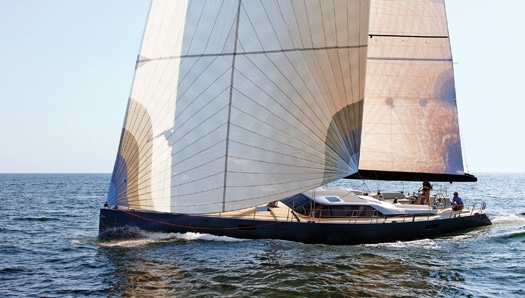
ytgjan5hodg525.jpg
Chesapeake Bay, even on a sunny day this past October, was the color of tarnished pewter, tinged with pale green. Winds blew down the bay, bouncing between 13 and 25 knots for most of the afternoon. The H65 Café Racer danced over the moderate seas at a daylong average of nearly 10 knots-at one point holding 9.5 knots under double-reefed mainsail and small staysail. Typical of Tripp’s recent designs, Available has a plumb stem, fine entry, and U-shape sections below the waterline forward, transitioning to semi-elliptical sections through amidships and flatter still in the after sections. The shape perfectly marries seakindliness and low wetted surface area with minimal wave-making resistance-a trait shared by all of Tripp’s designs I’ve sailed. Although we had more than enough wind to test our suspicion that Available could easily exceed the time-honored speed/length ratio of 1.34, we had only a lightweight asymmetrical spinnaker, and Captain John-Paul (JP) DeRoy felt that we didn’t have enough sea room. Hank Hinckley, production manager at Hodgdon Yachts, thought that the spinnaker we had aboard wasn’t heavy enough to cope with the wind and wasn’t willing to risk blowing it to shreds. Also on board with me that day were Graham Wright, the owner’s project manager; Jonathan Chapman, Available’s listing broker and an experienced sailor from Northrop and Johnson; and two of JP’s friends, Tom Tanner and his first mate Tracy, who run a 75-foot iteration of the Café Racer concept. JP lowered the bow and stern thrusters and eased us off the dock, all the while holding the yacht parallel to the float until we cleared the boat in front and the one behind us. We picked our way through the impossibly crowded mooring field in Back Creek and motored at 7 knots toward deeper water. This speed seemed effortless, the Volvo Penta auxiliary humming quietly within its home amidships under the centerline settee of the dinette. When the chart showed deep water on all sides and ahead of us, we lowered the keel, which is powered by a Harken hydraulic system. Lowering and lifting the keel wants patience from the crew, because moving 12 tons of lead through 5 feet simply requires a certain amount of time-I’d say a few minutes, though I failed to record the actual number. As the keel lowered, water rushing over its surface sent up a shudder. Following common practice in the design of high-performance yachts, Tripp gave the H65 a hydrodynamic keel of short chord (fore-and-aft dimension). It wears a torpedo-shape ballast bulb on the tip. This style of keel requires sharp helmsmanship in light air to keep it from stalling. The big, balanced rudder-which penetrates the water to a depth roughly equal to that of the keel when it’s fully raised-contributes to the yacht’s overall lateral resistance. Steering was impressively quick and accurate.
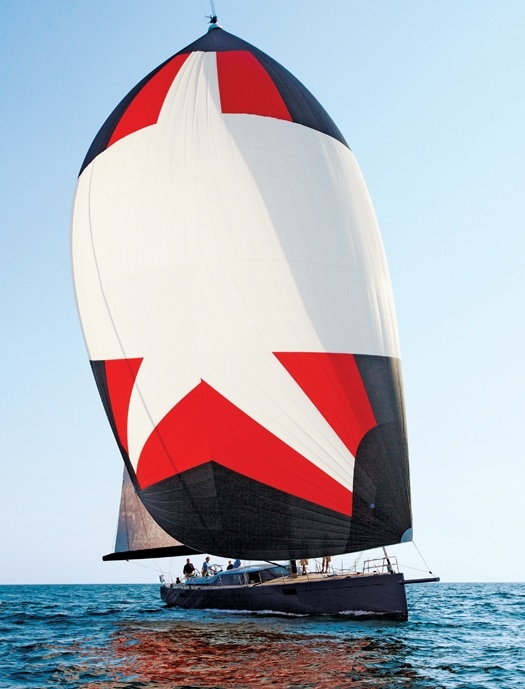
| | |
As the keel made its journey to full depth, the crew unzipped the mainsail’s cover. Hall Spars made the carbon-fiber mast and the boom, which has a V-shape and completely houses the sail when it’s fully lowered. Lazy jacks contain the mass of North 3DL cloth as it descends. This is a neat package, though not as easy to deal with as a Leisure Furl system. We headed into the wind and hoisted the main. A Harken electric winch made this exercise remarkably easy, the hardest part of which seemed to be coiling the tail of the halyard after the sail reached the top of its traveler. We unfurled the jib and bore off on a broad reach. The overlapping jib sheets lead to adjustable transverse leads. Tripp says that this system allows more flexibility in trimming the jib over a wider range of apparent wind angles than does fore-and-aft lead adjusters. I took notes while members of the crew spelled one another on the helm: Apparent wind angle 85 degrees, true wind speed of 6.4 knots (we’d sailed into a hole), boat at 4.6 knots over the ground; A/W angle 80 degrees, T/W speed 8.3 knots, boat 5.8 knots. We headed up to an A/W angle of 55 degrees and saw T/W speed of 8.3 knots, at which point the boat touched on 8.5 knots. Then at a wind angle of 102 degrees and true wind speed of 18 knots, the boat hit 10.4 knots. When I took the helm, I pocketed my notepad and left it there for the duration. What a ride! We tacked and jibed as the sailing room dictated. As the wind built to better than 20 knots, we reduced the mainsail to the first reef point and rolled up a bit of the jib. JP didn’t like the set of the reefed jib, so we changed to the trysail, a small, non-overlapping handkerchief of a sail, set on a composite stay. The boat seemed to prefer this combination. Then we took in the second reef on the main, and the H65 settled into a comfortable 10-plus-knot gait, easing the weather helm that I experienced when she was overpowered. The lesson here: A big rig means reefing early. How nice to know that you can reduce the effort of sailing without sacrificing speed. By the time I’d finished my stint at the helm, I was cold and excited.
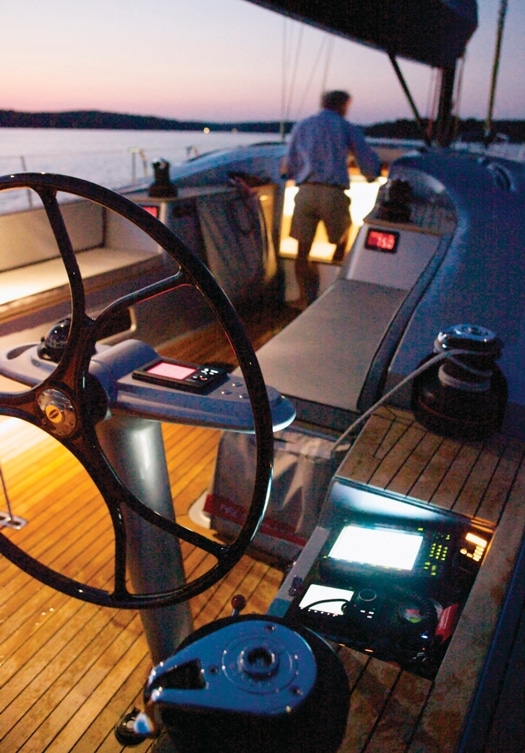
| | |
Performance, on the other hand, is only one part of a yacht’s appeal- and in many instances, not the most important. Looks and the general arrangement belowdecks often influence a buyer’s decision more. Anyone whose taste in yachts leans toward the Bauhaus theory that form should follow function will swoon over the simple elegance of the H65. Her profile results from the desire for maximum waterline length on a given LOA. The sugar scoop molded into the transom allows easy access to the water. Flush hatches on the foredeck and sail-handling lines led through tunnels to the cockpit keep decks free of clutter, eliminating booby traps for the crew and enhancing the yacht’s elegance. Even the lifelines, which sometimes detract from a sailboat’s aesthetic appeal, are exactly correct in style, so they nearly disappear from view. The ears of each mooring cleat fold down to form an ellipse, transforming these purely functional items into art. Unlike the low-slung blisters that often pass for deck houses on modern yachts, the house that Tripp Design drew for Available, though sleek, is more upright and, I think, a lot more practical, because it permits useful volume inside. Large windows in the front of the house, curved to meet the side windows and raked aft, light up the raised salon and galley like a bank of klieg lights. The rake of the forward windows and the moderate tumblehome of the side windows visually reduce the bulk of the house. The darkly tinted windows appear as a single unit in the daylight. The mullions that separate them show only when the salon is lit from inside at night. Tripp placed the dinette a couple of steps up from the sole of the house, and this gives the occupants, even short ones, a wonderful view of their surroundings. Cushions of relatively dense foam, upholstered in a neutral shade of Ultraleather, encourage the owner and his guests to linger over coffee and after-dinner drinks well into the night.
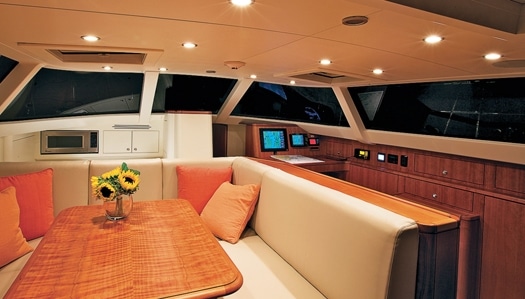
| | |
A unique construction method has added significantly to the ambience belowdecks. Hodgdon laminated the hull over a male mold via the resin infusion process. Before the shop crew laid on the carbon fiber, they covered the mold with cedar strips, as though they were strip-building the entire hull. The strip-planking remained in the hull, serving as traditional ceilings in the spaces below and, even more important, muffling the natural resonance of the carbon structure. The cedar strips, painted white in most of the accommodations, also add a level of class to the big lazarette in the stern and to other stowage areas. The master stateroom is forward and has all the stowage its occupants will need for extended cruises. Guest quarters are all the way aft-twin berths in the portside stateroom and a double in the starboard cabin. Each has a private head, but these will also serve as day-heads. Cherry joinery and a soothing matte-white Awlgrip on the other surfaces brighten the interior.
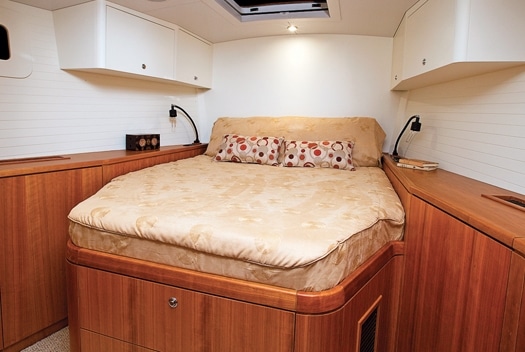
| | |
Available is on the market for $4,950,000 and is worth every cent to anyone who wants to cruise at exhilarating speeds. Powered up with electric and hydraulic systems to handle the hard work, she’ll be ideal for a cruising couple, one that occasionally likes to invite guests for short stays, and who love a fun ride. Hodgdon Yachts, (207) 633-4194; www.hodgdonyachts.com; Northrop and Johnson, (401) 848-5500; www.northropandjohnson.com









